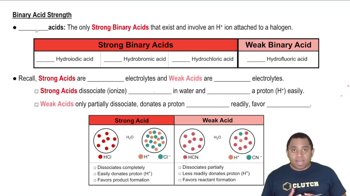Here are the essential concepts you must grasp in order to answer the question correctly.
Acid Strength and Dissociation
Acid strength is determined by the degree to which an acid dissociates in solution to release protons (H+ ions). Stronger acids dissociate more completely, resulting in a higher concentration of H+ ions in solution. The ability of an acid to donate protons is influenced by its molecular structure and the stability of the resulting anion.
Recommended video:
Oxidation State of Central Atom
In oxyacids, the oxidation state of the central atom (usually a nonmetal) plays a crucial role in determining acid strength. Higher oxidation states typically lead to stronger acids because they stabilize the negative charge on the conjugate base after dissociation. For example, in the series HClO, HClO2, HClO3, and HClO4, the central chlorine atom's increasing oxidation state enhances the acid's ability to donate protons.
Recommended video:
Electronegative Atoms and Inductive Effect
The presence of electronegative atoms in an acid can influence its strength through the inductive effect. Electronegative atoms pull electron density away from the O-H bond, weakening it and making it easier for the acid to release a proton. In the case of the chlorous acids, the addition of more oxygen atoms increases the overall electronegativity, thereby enhancing the acid's strength as seen in the increasing order from HClO to HClO4.
Recommended video:
 Verified step by step guidance
Verified step by step guidance

